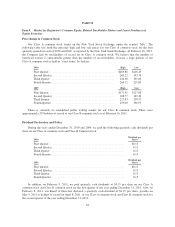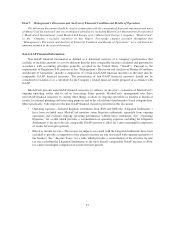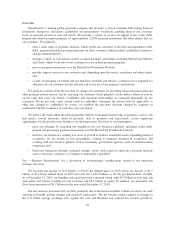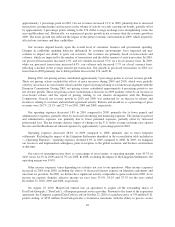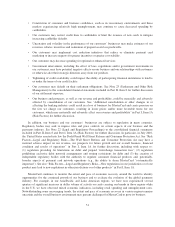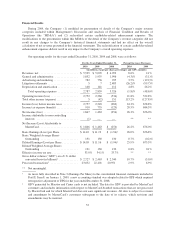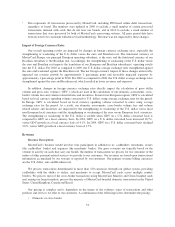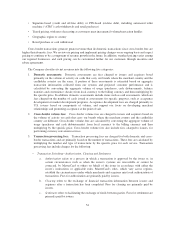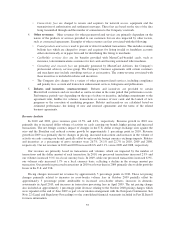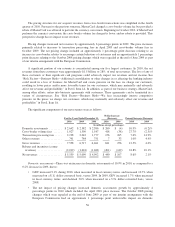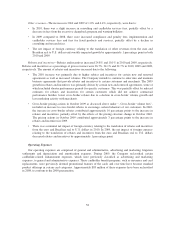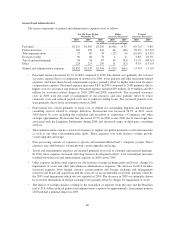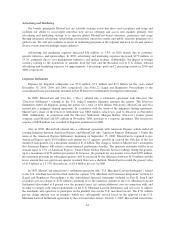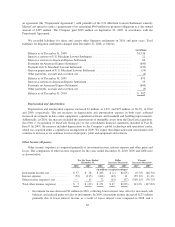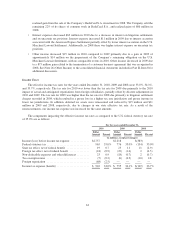MasterCard 2010 Annual Report Download - page 64
Download and view the complete annual report
Please find page 64 of the 2010 MasterCard annual report below. You can navigate through the pages in the report by either clicking on the pages listed below, or by using the keyword search tool below to find specific information within the annual report.• Signature-based (credit and off-line debit) or PIN-based (on-line debit, including automated teller
machine (“ATM”) cash withdrawals and retail purchases)
• Tiered pricing, with rates decreasing as customers meet incremental volume/transaction hurdles
• Geographic region or country
• Retail purchase or cash withdrawal
Cross-border transactions generate greater revenue than do domestic transactions since cross-border fees are
higher than domestic fees. We review our pricing and implement pricing changes on an ongoing basis and expect
pricing to continue to be a component of revenue growth in the future. In addition, standard pricing varies among
our regional businesses, and such pricing can be customized further for our customers through incentive and
rebate agreements.
The Company classifies its net revenues into the following five categories:
1. Domestic assessments: Domestic assessments are fees charged to issuers and acquirers based
primarily on the volume of activity on cards that carry our brands where the merchant country and the
cardholder country are the same. A portion of these assessments is estimated based on aggregate
transaction information collected from our systems and projected customer performance and is
calculated by converting the aggregate volume of usage (purchases, cash disbursements, balance
transfers and convenience checks) from local currency to the billing currency and then multiplying by
the specific price. In addition, domestic assessments include items such as card assessments, which are
fees charged on the number of cards issued or assessments for specific purposes, such as acceptance
development or market development programs. Acceptance development fees are charged primarily to
U.S. issuers based on components of volume, and support our focus on developing merchant
relationships and promoting acceptance at the point of sale.
2. Cross-border volume fees: Cross-border volume fees are charged to issuers and acquirers based on
the volume of activity on cards that carry our brands where the merchant country and the cardholder
country are different. Cross-border volume fees are calculated by converting the aggregate volume of
usage (purchases and cash disbursements) from local currency to the billing currency and then
multiplying by the specific price. Cross-border volume fees also include fees, charged to issuers, for
performing currency conversion services.
3. Transaction processing fees: Transaction processing fees are charged for both domestic and cross-
border transactions and are primarily based on the number of transactions. These fees are calculated by
multiplying the number and type of transactions by the specific price for each service. Transaction
processing fees include charges for the following:
•Transaction Switching—Authorization, Clearing and Settlement.
a. Authorization refers to a process in which a transaction is approved by the issuer or, in
certain circumstances such as when the issuer’s systems are unavailable or cannot be
contacted, by MasterCard or others on behalf of the issuer in accordance with either the
issuer’s instructions or applicable rules. MasterCard’s rules, which vary across regions,
establish the circumstances under which merchants and acquirers must seek authorization of
transactions. Fees for authorization are primarily paid by issuers.
b. Clearing refers to the exchange of financial transaction information between issuers and
acquirers after a transaction has been completed. Fees for clearing are primarily paid by
issuers.
c. Settlement refers to facilitating the exchange of funds between parties. Fees for settlement are
primarily paid by issuers.
54


